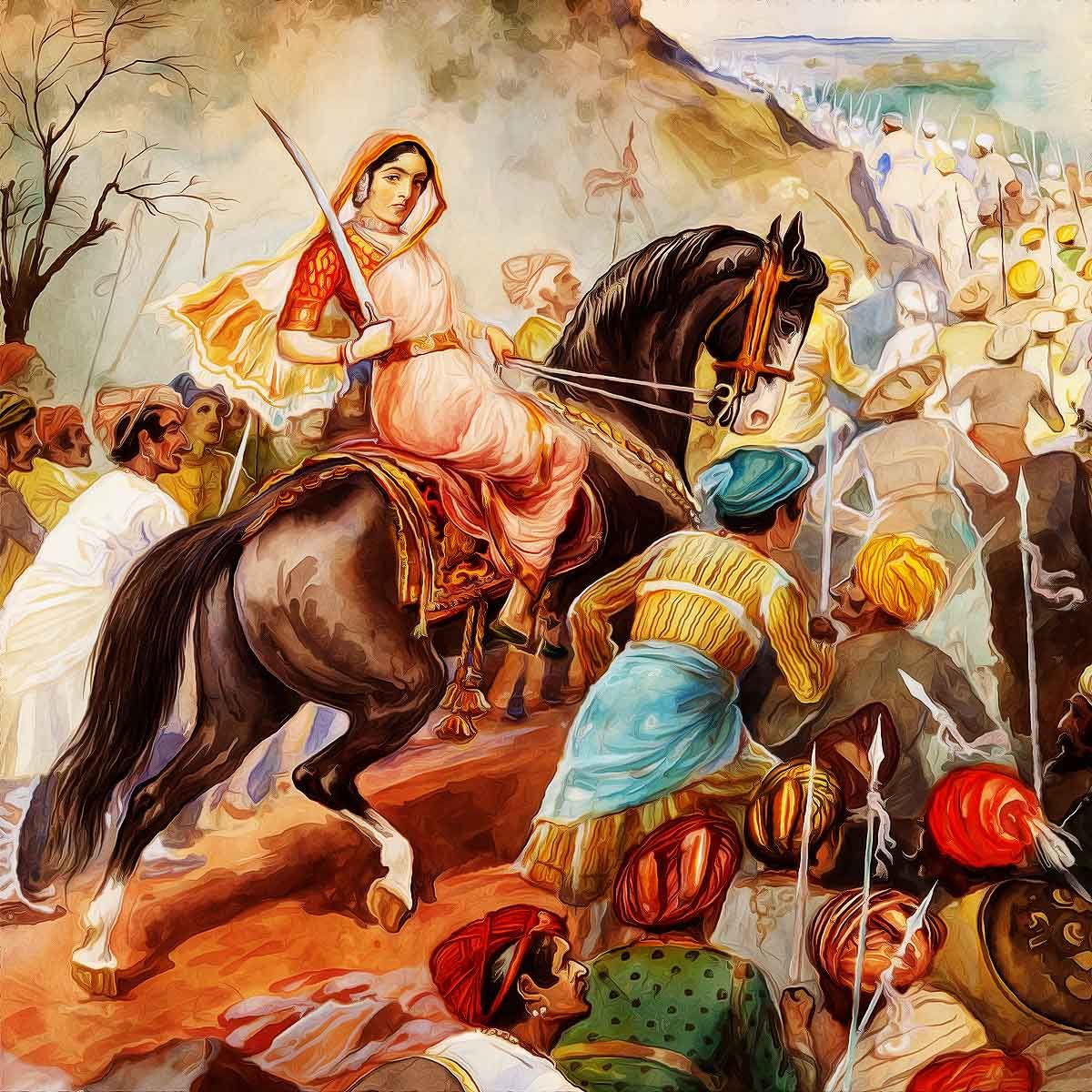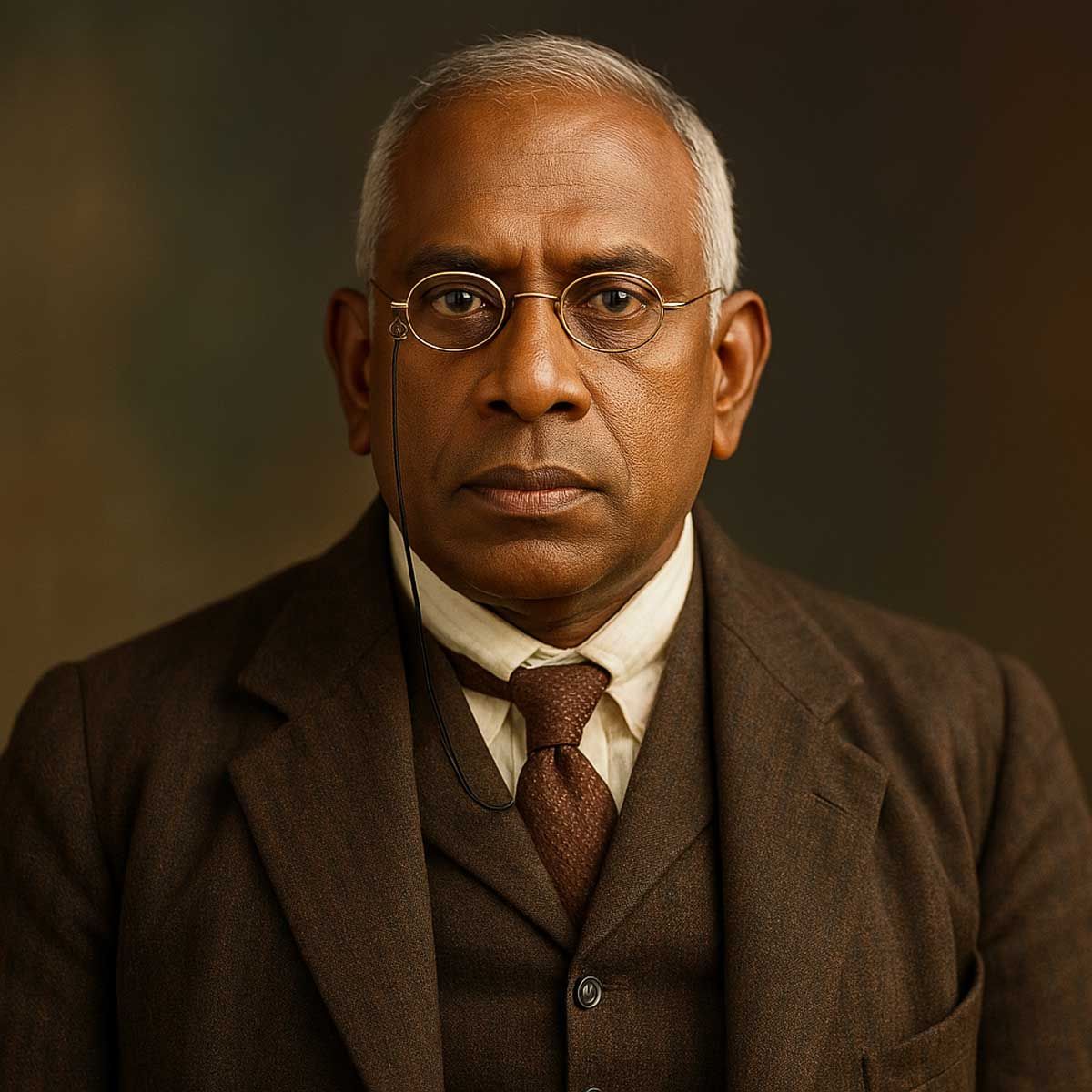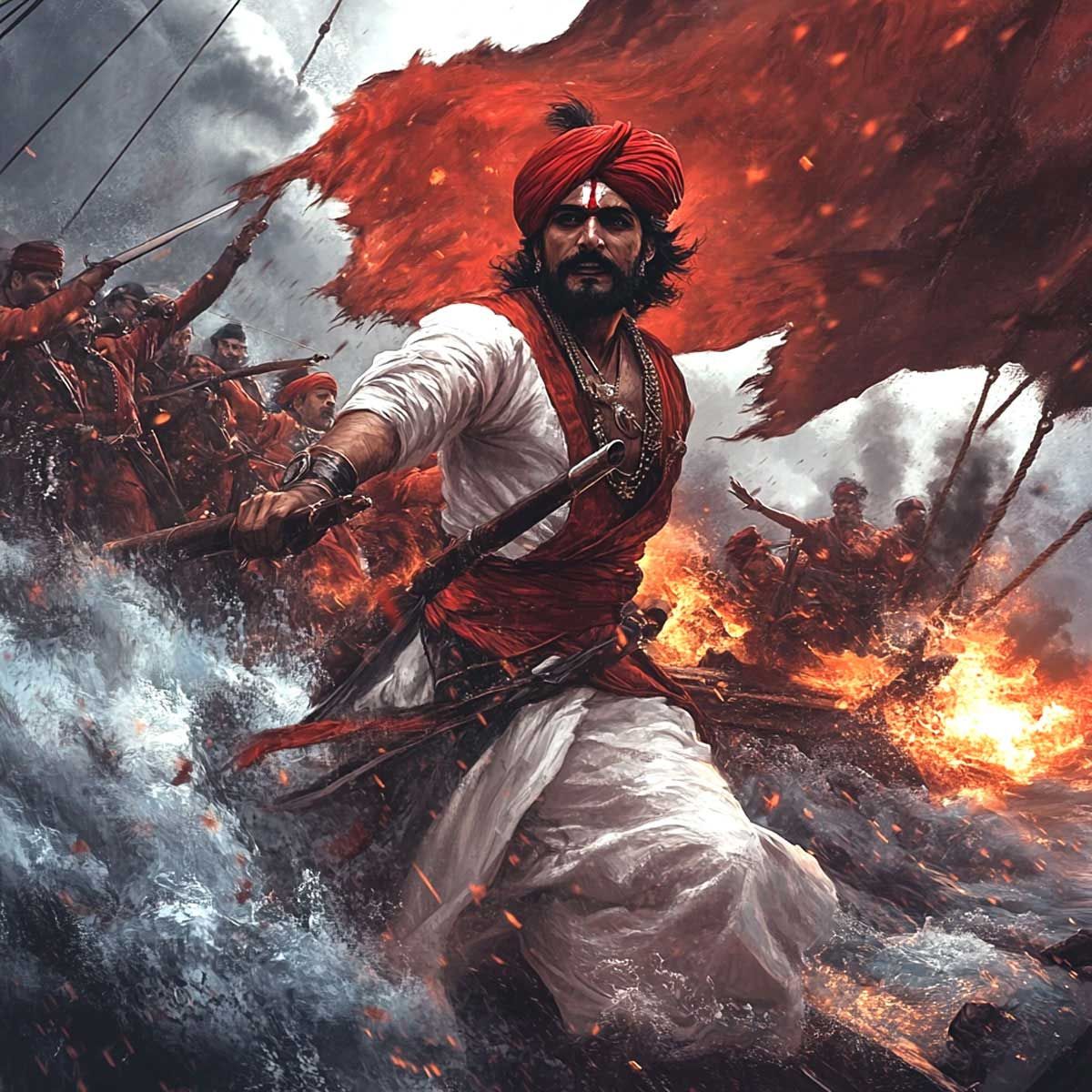More Coverage
Twitter Coverage
Satyaagrah
Written on
Satyaagrah
Written on
Satyaagrah
Written on
Satyaagrah
Written on
Satyaagrah
Written on
Join Satyaagrah Social Media
"Courage is contagious. When a brave man takes a stand, the spines of others are often stiffened": Tarabai Bhosale - Maratha Queen who singlehandedly led a successful war against the forces of one of the mightiest rulers Aurangzeb

Tarabai Bhosale was the daughter-in-law of Chhatrapati Shivaji Maharaj and the queen of Chhatrapati Rajaram Bhosale.
|
She ruled the Maratha Empire from 1700 until 1708 as the Queen Regent as the heir to the throne Shivaji II was a minor when the king died. After the death of Rajaram Bhosale, Mughal attacks on Maratha supremacy continued. But Tarabai Bhosale dealt it with an iron hand. She herself led her army into the battlefield and successfully fought against the Mughal forces.
According to Jadunath Sarkar, a prominent Bengali historian, it was because of the administrative genius and strength of Tarabai that the Maratha Empire survived the awful crisis from 1700 to 1707. During this time Mughals tried their best to occupy Maratha territories but in vain. But have we ever read about the unflagging courage and indomitable spirit of this brave daughter of Bharat Mata? Ironically never, except a few from Maharashtra!
The Marathas comprised of 96 clans — 60 Somvanshi and 36 Suryavanshi. Mohites belong to the Maratha Royal Deshmukh clan. Tarabai Bhosale was a Mohite. She was the daughter of Maratha general Hambirao Mohite. Since her childhood, she was fiercely independent.
|
Rather than taking part in activities pertaining to girls of her age, she was more interested in getting trained in the art of warfare. She was inspired by the heroic exploits of her commander father. She was well-trained in the art of sword fighting, archery, cavalry, and war tactics. She learned military strategy from her father.
Tarabai Bhosale was married to Shivaji’s younger son Rajaram Bhosale when she was eight years old. Rajaram Bhosale was older to her by 5 years. She was Rajaram’s second wife. Rajaram was then already married at the age of ten to Jankibai, the daughter of Prataprao Gurjar, the chief of Shivaji’s Maratha army. Hambirao Mohite later succeeded Prataprao Gurjar as the Maratha army chief. Rajaram was also married to Rajasbai Ghatge from Kagal.
Before we delve about Tarabai Bhosale, let us dig into the history of the Marathas to know better about the situation when she became Queen Regent and what led to war with the Mughals. The occasional war between the Mughals and Marathas, also termed the 27 Year War or Maratha War of Independence started in the year 1680 in the Deccan after the death of Shivaji.
It started with Aurangzeb’s invasion of the Maratha enclave in Bijapur. Even before this, after the establishment of the Maratha kingdom by Shivaji in 1674, there were constant conflicts with the Muslim rulers, but Shivaji resisted the attacks.
|
Do you know during Shivaji’s reign the Maratha Empire had about 300 forts with 50,000-foot soldiers, 40,000 cavalries, and a strong naval base along the west coast?
The 27-year war that started in 1680 ended in 1707 with the death of Aurangzeb. Initially, Shivaji’s successor Sambhaji gave stiff resistance to the Mughal forces. After his death in 1689, Marathas under Rajaram Bhosale continued with the resistance efforts until the king died of an illness in 1700. And then Tarabai Bhosale took the reins of the Maratha kingdom in her hands and offered stiff resistance to the Mughal forces.
Rajaram Bhosale was born to Shivaji and his younger wife, Soyarabai. After the death of Shivaji, Sambhaji, who was the elder son and 13 years older than Rajaram, was a strong contender for the Maratha throne. Soyarabai conspired with a few of the Maratha nobility and installed Rajaram as the king.
However, Sambhaji claimed the throne after winning over the Maratha generals to his side. He imprisoned Soyarabai and Rajaram and got rid of the nobility who supported them. Meanwhile, the Mughal-Maratha war continued. Soyarabai and Rajaram remained in prison until Sambhaji was captured and executed by the Mughals in 1689. The Maratha nobility freed the duo and Rajaram Bhosale became the king of the Maratha Empire.
Rajaram was crowned at Raigad on 12 March 1689 at the age of 19. On 25 March 1689, the Mughals started laying siege to the region around Raigad. The Marathas fought with the Mughals and managed to let Rajaram escape through Kavlya ghat to Tamil Nadu. He was to seek refuge in the fort of Jinji.
Rajaram reached the fort of Keladi in disguise and sought refuge from queen Chennamma and asked her for help for his safe passage and escape to Jinji Fort. The queen knew that if she gave shelter to Rajaram, the robust Mughals would certainly attack her kingdom. Yet she wasn’t bothered.
|
Aurangzeb sent a messenger with a letter along with diamonds and precious stones to the Keladi court asking Rani Chennamma to hand over Rajaram to him. By the time the messenger reached her court, the queen had already facilitated Rajaram’s safe escape to Jinji fort. The queen replied that handing over Rajaram was impossible. Aurangzeb had already sent his son Azamath Ara with a huge army to invade Keladi.
Do you know Rani Chennamma almost defeated the Mughal forces when the latter proposed for a peace treaty? The Rani agreed for peace. Rajaram Bhosale remained in Jinji for a few years and then continued the Maratha Mughal war until his death in 1700.
After the death of Rajaram Bhosale, there were two legal heirs (both minors) to the throne — Shivaji II, Tarabai Bhosale’s son, and Sambhaji II, Rajasbai’s son. Shivaji II was an elder, then aged only four years. Tarabai Bhosale proclaimed her son Shivaji II as the heir to the throne and successor to Rajaram and declared herself as Queen Regent, taking charge of the administrative, judiciary, and military powers of the Maratha Empire.
Ramchandra Nilkanth, the veteran administrator of the Maratha Empire during Rajaram’s presence in Jinji, wanted Sambhaji’s son Shahuji to claim the throne. But Shahuji was then under the custody of Aurangzeb. Tarabai Bhosale carried out the royal thread ceremony of her son in the hill fort of Vishalgarh with the help of her supporters.
Tarabai Bhosale was 25 years old when she became the Queen Regent of the Marathas. Mughal chronicler Khafi Khan wrote about Tarabai, “The chiefs then made Tarabai, the chief wife and the mother of one son (of Rajaram) Regent. She was a clever intelligent woman, and had obtained a reputation during her husband’s lifetime for her knowledge of civil and military matters.”
When Rajaram was in Jinji Fort, the teenage Tarabai stayed at Panhala. Under the tutelage of Ramchandra Nilkanth, she studied statecraft and administrative knowledge. She further trained herself in military affairs. Later she joined her husband at Jinji. In the words of Richard M. Eaton, author of A Social History of the Deccan, 1300-1761: Eight Indian Lives, Volume 1, “The experience and skills gained at this time evidently infused her with considerable self-confidence. For in February 1699, after she and Rajaram had returned to Maharashtra from Jinji, it was Tarabai, not her husband who resolved a dispute between the kingdoms’ commander-in-chief Dhanaji Jadhav and another prominent chieftain.” Tarabai Bhosale decided the dispute against the powerful Dhanaji Jadhav.
After Tarabai Bhosale assumed power, she became the supreme force of the Marathas. She regulated things so well that not a single Maratha leader acted without her order. And the power of the Marathas increased by the day, proof of which was chronicled by Muslim historian Khafi Khan. He wrote about her, “She won the hearts of her officers, and or all the struggles and schemes, the campaigns and seizes of Aurangzeb up to the end of his reign, the power of the Marathas increased day by day.” The Portuguese in Goa termed her the ‘Queen of the Marathas.’
Tarabai Bhosale singlehandedly directed Maratha's defense against Mughal forces sent by Aurangzeb from 1700 to 1707. Aurangzeb was then deemed one of the mightiest rulers, but his might failed in front of Tarabai. She moved tirelessly from fort to fort and motivated the Maratha forces. She mobilized resources and mastered Aurangzeb’s own game of offering bribes and counter-bribes to commanders on both sides of the conflict.
Indian kings often strategized about launching an offensive against enemy forces and creating terror in their minds. This involved setting out to invade enemy territories even before the enemy thought about planning an attack. This strategy often helped check the enemy’s future plans of attack.
|
Narasimhadeva of Orissa followed this strategy and defeated Turkic Afghan Tughan Khan in 1244 AD. For several years the Delhi Sultanate and the Nawabs of Bengal did not even think of attacking Narasimhadeva’s territory after this strategy worked. Tarabai Bhosale followed a similar strategy. She sent large forces beyond the Maratha-speaking Deccan deep into Mughal territories to the north. This she did despite Maratha forts in the Deccan falling into Aurangzeb’s hands.
Here is a list of successful raids by Marathas under Tarabai Bhosale as part of the above strategy:
- 1700 AD: She sent a troop of 50,000 soldiers as far north as the region west of Chanderi in modern Guna of northwestern Madhya Pradesh
- 1702: Invaded Khandesh, Berar, and Telangana, Maharashtra’s northern and eastern borderlands
- 1703: Attacked urban centers in Khandesh and Malwa (Ujjain, Burhanpur, Munda, Sironj)
- 1705: Attacked cities in Gujarat and Khandesh.
Khafi Khan wrote about these raids of Tarabai Bhosale, “They penetrated into the old territories of the Imperial throne, plundering and destroying wherever they went…. The commanders of Tarabai cast the anchor of permanence wherever they penetrated, and having appointed kamaish dars (revenue collectors), they passed the years and months to their satisfaction, with their wives and children, tents, and elephants. Their daring went beyond all bounds. They divided all the districts (parganas) amongst themselves, and following the practice of the Imperial rule, they appointed their Subadars (provincial governors), kamaish dars (revenue collectors), and rahdars (toll collectors).”
After the death of Aurangzeb in 1707, the 27-year war between the Marathas and the Mughals ended. Shahuji was released by the Mughals. He claimed the Maratha throne.
As he was Sambhaji’s son and Shivaji II was still a minor, most of the Maratha nobility supported Shahuji. Tarabai Bhosale was sidelined.
The Maratha queen then established a rival court in Kolhapur in 1709. But she was deposed by Rajasbai who put her own son Sambhaji II on the throne. Tarabai and Shivaji II were imprisoned by Rajasbai. Shivaji II died in 1726. Tarabai was released from prison after she reconciled with Shahuji. But she was left with no political power.
Tarabai assumed some power during her later years. She breathed her last at the age of 86 in December 1761 after the 3rd Battle of Panipat which saw the Maratha army decimated by Ahmad Shah Abdali.
Had the brave Tarabai Bhosale not taken charge of Maratha power in 1700, the Marathas might have faced a similar defeat long beforehand. Had she continued ruling as the queen after 1707, the History of the Marathas would have been different. Maybe they would have established Hindu supremacy by subjugating the Mughals and ending their rule! The 7 years of her successful raids and attacks into Mughal territory corroborate this.
Salute to Tarabai Bhosale! Jai Hind!
|
REFERENCES:
Saffron Swords: Centuries of Indic Resistance to Invaders - Manoshi Sinha Rawal, Yogaditya Singh Rawal
 Support Us
Support Us
Satyagraha was born from the heart of our land, with an undying aim to unveil the true essence of Bharat. It seeks to illuminate the hidden tales of our valiant freedom fighters and the rich chronicles that haven't yet sung their complete melody in the mainstream.
While platforms like NDTV and 'The Wire' effortlessly garner funds under the banner of safeguarding democracy, we at Satyagraha walk a different path. Our strength and resonance come from you. In this journey to weave a stronger Bharat, every little contribution amplifies our voice. Let's come together, contribute as you can, and champion the true spirit of our nation.
 |  |  |
| ICICI Bank of Satyaagrah | Razorpay Bank of Satyaagrah | PayPal Bank of Satyaagrah - For International Payments |
If all above doesn't work, then try the LINK below:
Please share the article on other platforms
DISCLAIMER: The author is solely responsible for the views expressed in this article. The author carries the responsibility for citing and/or licensing of images utilized within the text. The website also frequently uses non-commercial images for representational purposes only in line with the article. We are not responsible for the authenticity of such images. If some images have a copyright issue, we request the person/entity to contact us at This email address is being protected from spambots. You need JavaScript enabled to view it. and we will take the necessary actions to resolve the issue.
Related Articles
- "Courage makes a man more than himself; for he is then himself plus his valor": Surya Sen - hero behind Chittagong armory raid & attack on Europeans only club that shook British like never before, brutally tortured and executed by British on Jan 12, 1934
- "Kuyili - the first suicide bomber of India during freedom struggle": Army commander of queen Velu Nachiyar poured ghee over herself and entered ammunition warehouse of Britishers resulting in an explosion that defeated British
- "Some heroes are made in a moment. Others are defined by a lifetime": Prime Minister Modi names 21 islands of Andaman and Nicobar after 21 Param Vir Chakra awardees, memory and lionisation of Netaji Subhash Chandra Bose as a national hero loomed large
- Saraswathi Rajamani, at 16, became the youngest and first female spy for INA, boldly recruited by Netaji in 1942, courageously spent two years spying on the British in Myanmar during WWII, a pivotal yet overlooked heroine in India's struggle for freedom
- Our first true war of independence lie forgotten within the fog of time and tomes of propaganda: Sanyasi Rebellion, when "renouncers of the material world" lead peasants in revolt against British and fundamentalist islamic clans
- Add Vedas and review freedom fighter's portrayal in School textbooks: Parliamentary Committee on Education
- "The sword of revolution is sharpened on the whetting stone of ideas": Veer Baikunth Shukla, was executed by the British for avenging the death of Bhagat Singh, Sukhdev and Rajguru by killing the traitor Phanindra Nath Ghosh who had become a govt approver
- "A horse gallops with his lungs, perseveres with his heart, and wins with his character”: Shubhrak seeing his master in danger became uncontrollable and threw Qutubuddin on the ground, stomped his chest and head with mighty hooves killing him on the spot
- Godse's speech and analysis of fanaticism of Gandhi: Hindus should never be angry against Muslims
- Martyrs’ march into the history - Rajguru: The Invincible Revolutionary
- A troubled childhood - Rajguru: The Invincible Revolutionary
- How Britishers were challenged by 83 year old Ropuiliani in Mizoram in 1892-’93
- "The tyrant dies and his rule is over, the martyr dies and his rule begins": Baji Rout, a boat boy - youngest martyr of India's freedom struggle who was manhandled, threatened & skull fractured but refused to ferry British police across the Brahmani River
- Cross Agent and the hidden truth of massacre of Jallianwala Bagh - Martyrdom of Shaheed Bhagat Singh (Some Hidden Facts)
- Debunking the myth of "De Di humein Aazadi Bina Khadag Bina Dhal": Bharat’s founding story bestows upon it an extravagant national philosophy and long-lasting costs
























